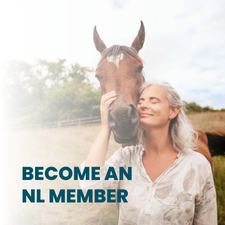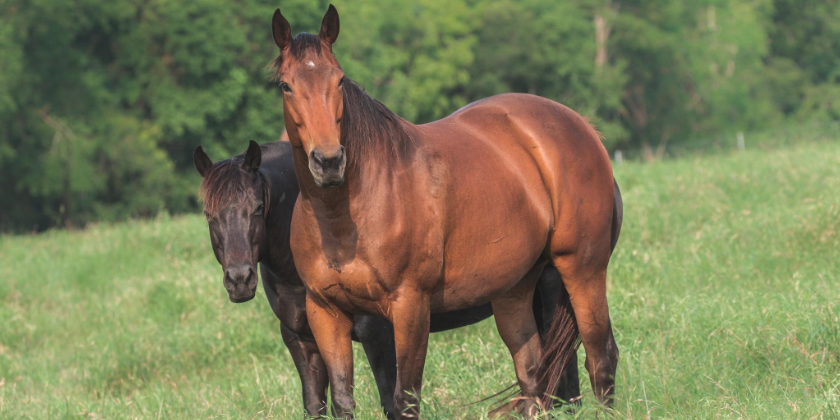By Bettina Shultz-Jobe, Tim Jobe, Laura McFarland, and Kate Naylor
The following is an excerpt from the Natural Lifemanship Manual. Our manual is intended to serve as a resource to support students’ learning as they move through our Fundamentals and Intensive trainings. (The suggested citation is at the end of this article)
Additionally, much more is taught about this subject in week 5 of the Fundamentals of NL. This subject is also covered in this free webinar.
On every website for programs and practitioners utilizing equine assisted services (EAS) you are bound to find a page called, “Why Horses?” And rightly so. Answering this question is vital to legitimizing our field and building a valid and intentional practice of EAS.
As professionals including sentient beings as partners in healing work, answering the question “why” is our ethical obligation, and drives everything we do.
The answers to this question (and there are many) will inform our planning before sessions, our choices within sessions, our processing after sessions, and our care for our horses throughout.
First, why do we call our business Natural Lifemanship?
If you’re a horse person you know that Natural Lifemanship is a play on words from Natural Horsemanship (a horse training approach that has grown in popularity since the 1980’s), but it is also a clear departure from it.
Fundamentally, we teach a different way of thinking about the nature of the horse/human relationship, and we believe that the principles of how we engage with our horses should be the same as with humans and the rest of the world of which we are a part. When beliefs and underlying principles change, behaviors and techniques are organically transformed. We don’t have to prescribe techniques, for either humans or horses, when there is a clear and embodied understanding of guiding principles and beliefs.
The emergence of Natural Horsemanship was, thankfully, the beginning of more widespread, humane treatment of horses. That said, oftentimes, the underlying principles are still steeped in power, domination, and control. Kinder, gentler control is still control. Mind control is still control. Natural Lifemanship began a revolutionary change in the beliefs and principles at the heart of all healthy relationships, including those with horses.
At times, we use similar terms but they often have different meanings and unique logic that governs them. Sometimes we change the term to reflect the differences, and sometimes we seek to reclaim the word being used.
Through your training with us, you will begin to understand why we say “It’s not about horsemanship, it’s about lifemanship. AND it’s all about the relationship!”
These principles, which focus on the health of the relationship first and foremost, are not only about horses, and not only about humans – they are guides to relating to the world, and our lives, at large. This is where the conversation about “why horses” begins. And so, we call this Natural LIFEmanship.
Our Equines’ welfare depends on how we answer the question “Why Horses?”
Equine assisted services is the fastest growing equine related field in the world, and the truth is, our industry is one of the few that puts the welfare of the equines we work with at the forefront of the conversation. How we interact with our equines now, the methods we choose and the ideals we put forth, will no doubt influence the rest of the equine industry.
In this way, we have a responsibility to think deeply about this question of “why horses”, and about how we answer this question. In order to attempt to answer it satisfactorily we want to talk about a few big concepts. Since our approach is grounded in the sentience, consent, and individuality of horses, new questions arise that may not have been explored before. First, what is objectification (a common practice we argue has no place in equine assisted services)? Second, what is a horse, really? And lastly, what is a horse not?
The Subject of Objectification as it Relates to Horses
One way we have looked at equine welfare is through the work of Martha Nussbaum. Martha Nussbaum is a philosopher and law professor at the University of Chicago and speaks and writes on the subject of objectification, particularly as it relates to feminism.
She, of course, is speaking of humans, but what she expresses aligns with our principles and fits for all living beings, as we see it. At the core of objectification is power, domination, and control whether we are speaking of humans or animals.
And when we think about trauma, what is underlying the traumatic experience is often power, domination and control. So we must become incredibly intentional about how we interact with our horses in this work so as to not unintentionally re-enact the trauma that brought so many of our clients to us in the first place.
Let’s look at some of Nussbaum’s tenets of objectification:
- Instrumentality, treating the other as a tool for his or her purposes.
- Denial of autonomy, treating the other as lacking in autonomy or self-determination.
- Fungibility, treating the other as interchangeable with others of the same type – as though each individual is mutually interchangeable.
- Violability, treating the other as lacking in boundary integrity and violable. This one is foundational to the concept of consent.
- Denial of subjectivity, treating the other as though there is no need for concern for their experiences or feelings.
- Ownership, treating the other as though they can be owned, bought, or sold.

Reading through this list, you probably notice that most of these concepts currently and actively exist in our wider cultural paradigms about equines. What we must address then is, what does it do to our work when we objectify horses, and how do we objectify as little as possible?
Keep in mind that all of these concepts occur on a spectrum – even Nussbaum doesn’t name a tipping point at which we move into objectification, well, objectively. It is our aspiration though, to objectify as little as is possible – this requires a deep exploration of our beliefs and practices regarding equines.
Let’s break it down to the other two questions mentioned earlier…
What is a horse?
- A horse is a living animal, and more specifically, a mammal.
- A horse is a relational, herd animal.
- A horse is a sentient being.
- Each horse is an individual. If we truly want to have healthy, connected relationships with our horses we must shift our focus from what is good for the horse to what is good for this horse. Attunement is key, and at the core of the therapeutic work done in NL.
What is a horse not?
- A horse is not a tool or an instrument. If you find that you are using the horse like a tool, then it’s a good idea to utilize an inanimate object (a machine that mimics the movement of the horse, rocking chairs, swings, etc.). Way less liability and expense! Fewer ethical concerns.
- A horse is not a mirror or reflection of me. A horse is a living, breathing, sensing, feeling, and thinking being. A horse can certainly respond to me, but this is quite different from mirroring my internal experience in some way.
- A horse is not a metaphor. Objects are often powerful metaphors, but when doing therapy, learning, or coaching, a living being should never be a metaphor for another individual. However, our relational patterns can, indeed, surface in any relationship, including that with a horse. We can experience triggers by the ways in which another, including the horse, might behave similarly to someone else in our life, but the horse is not a metaphor for that person. The relationship with the horse is a real relationship where patterns emerge, triggers can happen, and conflict resolution is sometimes necessary.
- The horse is not a deity. A horse is not perfect. Not always present. Not always honest. (etc. etc. etc.) The desire for, or the illusion of, perfection always gets in the way of genuine connection. Deification is still objectification.
- A horse is not a human. In order to do ethical work in this field we must explore and celebrate similarities AND differences.
- A horse is not a therapist.
Some qualities that horses and humans share
- Horses have a mammalian brain and nervous system
- The nervous system of a horse can engage in fight, flight, freeze, and fawn
- Attachment, bonding, and relationship are basic needs
- Horses can embody trauma (i.e. hold onto trauma in their bodies)
- Horses can check out, submit, appease, and dissociate
- The horse’s brain, as a prey animal, naturally develops similarly to the traumatized human brain
- The horse’s brain is plastic (changeable) and use dependent
Why then do we partner with horses?
NL partners with horses because of the reciprocal relationship that is possible. Horses are capable of engaging in healthy, genuine connection, relationship, and partnership. This relationship can be profoundly deeper than words.
Within this relationship the client and horse are responding to each other which requires full body and brain activation and offers, when done consciously, a complete bottom-up brain experience. Horses do, indeed, invite us to clearly communicate beyond words with our entire being. They are beautifully sensitive to our internal states and energy, but this does not mean they are merely a metaphor or a mirror.
Why Do We Ride Horses?
The mounted work in particular can be especially healing – when done systematically there is proprioceptive and vestibular engagement, as well as the use of the other five senses, plus relational connection, and thinking. This is how we heal and build new neural pathways.
Often in trauma, particularly developmental trauma, we have to go back to repair and rebuild parts of neural pathways that were missed the first time around (in fetal development, infancy, and early childhood), or damaged due to trauma later in life. From a developmental perspective, the amount of brain activation and development that is occurring when a mother or caregiver holds an infant is critical to laying the foundation of future neural networks. We can mimic this with mounted work.
We can connect with the one who carries us!
In the womb, and later when a caregiver holds an infant, the two are responding to each other in movement, verbal and non-verbal communication, touch, emotion – it can be a full brain and body experience that is simply not possible when using the horse as a tool.
Can human relationship principles really transfer to horses?
We are often asked if we can really transfer human relationship principles to the horse and vice versa? The answer to this question can be found as we seek to understand the mammalian brain, body, nervous system, and attachment needs. This will be discussed at length as you continue to learn with NL.
When we embrace our similarities, we can truly embody what is meant by humane and ethical treatment of both horse and human.
Copyright © by Natural Lifemanship, LLC. All rights reserved.
SUGGESTED CITATION:
Jobe, T., Shultz-Jobe, B., McFarland, L. & Naylor, K. (2021). Natural Lifemanship’s Trauma Informed Equine Assisted Services. Liberty Hill: Natural Lifemanship.



Recent Comments